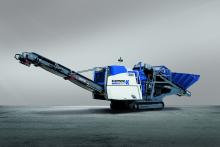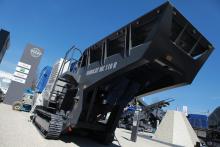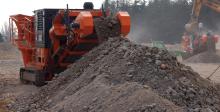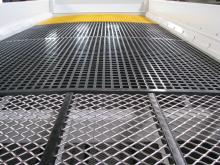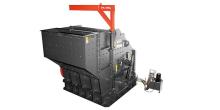
Mobility, efficiency and quality of the finished product are among the attributes being sought by, and delivered to, aggregates producers writes Patrick Smith.
Manufacturers have been showing off new equipment that offers all three, and a lot more, as they seek to increase market share.
For example, recent developments could be seen at
“We have always exported our technology across the African continent for the last 40 years because it is absolutely crucial to improve the existing infrastructures, roads, bridges, and our equipment is purposely designed and manufactured to meet the individual needs of our customers,” says Pietro Baioni, CEO at Baioni Crushing Plants.
At INTERMAT, Terex Finlay showed its new J-1170AS jaw crusher, built around the Terex 1,100mm x 700mm jaw crusher, and with an on-board detachable sizing screen as a key feature. Said to provide excellent material reduction and product sizing in the processing of blasted quarry rock and ore material, the J-1170AS’s jaw chamber is also available with optional hydraulic release, a key feature when crushing construction and demolition debris.
This has an automatic overload protection system to prevent damage by uncrushable items in the feed material.
The machine is powered by either a Tier 3/Stage 3A
Kleemann’s new mobile cone crusher, the Mobicone MCO 9 EVO, closes one of the final gaps in the company’s model range, and is compatible with the Mobicat MC 110 EVO mobile jaw crusher, having been developed especially for the needs of customers in the contractor market.
The drive concept, with a crusher direct drive as well as electric drives for the conveyor belts, is said to promise very efficient operation, and the 248kW drive unit is optimally used, thanks to a performance-enhanced crusher housing design. A continuous drive power at the crusher of 160kW is available. With crushing capacities of up to 260tonnes/hour, it is optionally equipped with an anti-spin system, which prevents the crusher cone from rotating, thus significantly reducing the wear in this area. Weighing 30tonnes, the MCO 9 EVO is said to be easy to transport and is ready for operation again quickly.
Targeted at the most demanding of aggregate producers, Sandvik Construction says it compact QS331 has been designed to accept large feed sizes and achieve high production capacities, and incorporates the S-type gyratory cone crusher into the 36tonne, self-contained, diesel driven track-mounted plant.
The CS430 cone crusher in the QS331offers a choice of three concaves and four bush settings to control the closed side settings (CSS) and material gradation, and due to the large feed acceptance, jaw crusher production may be optimised by opening the CSS, thereby also reducing fuel consumption and wear.
Offering an automatic level sensor above the crushing chamber to control the feed rate and minimise operator intervention for maximum production and reduction and an optional hanging screen available for recirculation or stockpiling to produce two products, the crusher is powered by a Cat C9 or C9.3 diesel engine with direct drive for maximum power delivery and fuel efficiency.
Metso has introduced its new HP5 cone crusher to the global market, and automatic settings, specialised maintenance tools, reduced emissions and energy-efficient motors are said to be just a few of the improvements to the crusher. It also features Metso’s IC70C crusher automation system.
“The Nordberg HP5 follows the successful HP3, HP4 and HP6 as the fourth model in an all-new range of high-performance cone crushers,” says Metso.
“The design of the new Nordberg HP5 leverages Metso’s 100-plus years of crusher knowhow and experience with more than 9,000 HP cone crushers in operation worldwide.”
The HP5 offers 5% larger feed size versus the HP400 and higher capacity than the HP500 in tertiary applications, while a higher cavity density is said to improve inter-particle crushing action for end products with more consistent gradation and superior shape.
“An advanced fastening system for the mantle and bowl liner eliminates the need for backing material, and makes liner changes safer and faster. Thicker liners result in more material to wear. The HP5 cone crusher is also easy to disassemble, and all components are accessible from the top or side. The bowl and head are easily and safely removed with no interference,” says Metso.
Also launching a new crusher is
The GT440 utilises a vibrating grizzly feeder with a large hopper and with an optional grizzly pre-screen designed to keep the crusher fed and operating efficiently. This consists of independent vibrating fingers that resist blinding and plugging.
The replaceable pre-screen module provides multiple settings for scalping unwanted material. The 1.5mx 3m two-deck screen offers 9.3m² of screen area.
The single toggle jaw crusher type STE 100.60 ASV is the centrepiece of the plant, and two innovations are said to assure more safety. A new overload protection function prevents “unbreakable” parts damaging or blocking the crusher while the crushing gap is opened by the automatic gap adjustment.
With a throughput capacity of up to 200tonnes/hour, the STE 100.60 ASV handles feed sizes of 950mm x 550mm, which can be processed to a final grain size of 0/50mm-0/200mm.
With the job site 1,600m above sea level, all of the rock excavation material was recovered from greywacke shale, with about 8,000m³ of material being crushed with the R900 and reused for different areas on the site.
Also in Austria, dsb, a local producer of mobile crushing and screening machines, is offering its new Innodrive drive system on the smallest of the dsb Innocrush machines, the Innocrush 30.
The crusher, with a rotor diameter of 1m, is directly driven with V-belts by an 186kW Caterpillar diesel engine. The belt tension varies hydraulically and is coupled with a running motor, while the company says the Innocrush 30, which weighs 30tonnes, has an output of 300tonnes/hour.
In neighbouring Germany, since January 2015, Holcim has operated the greywacke Kleinhammer quarry, which is located in the wooded mountainous region of Sauerland, near the town of Werdohl- Kleinhammer.
In close collaboration with the previous operator, Haver Niagara designed a new primary crushing plant for processing rip-rap. The company also supplied the complete conveying system, the intermediate silo and the dust silo as well as the planning of concrete works and the overall assembly.
An example of flexible production is the processing plant for rip-rap. The weight classes 5-40kg and 10-60kg can be processed separately or simultaneously on request by means of two heavy-duty screening machines.
In screening, Powerscreen’s productive and transportable Warrior 600 screen, which is said by the company to offer “ground-breaking simple conversion from three-way to two-way split mode,” can be containerised, offering a big reduction in its shipping costs. Dearbhaile Mulholland, Powerscreen’s marketing manager, says that at INTERMAT the Northern Ireland-based company had a lot of orders for this machine in Europe and North America, with orders also being placed by customers in Australia and South Africa.
The Warrior 600 screen can produce almost as much material as the next machine size up, the Warrior 800, and offers easy manoeuvrability, taking just 15 minutes to convert the machine from a three to a two-way split, says Barry O’Hare, Powerscreen’s European sales Manager
The Warrior 600 is said to be well suited for recycling, topsoil and C&D waste applications. The model also has a highly aggressive screen-box, said to allow for easy handling and separation of large items from material fines in recycling tasks, such as fines and rock from overburden and blasted rock.
The Warrior 600’s open chassis design is said to offer unrivalled access below screen to aid mesh changes. Its hydraulic folding conveyors also give excellent stockpiling capacity.

